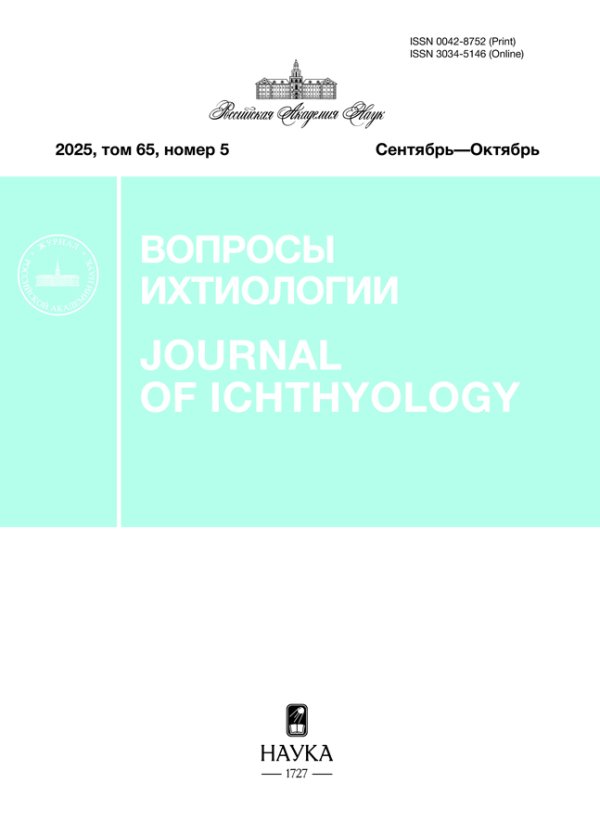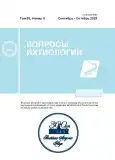Sexual Behavior and Reproductive Success of Guppy Poecillia reticulata (Poeciliidae) at a Constant Temperature and in the Temperature Gradient Field
- Authors: Zdanovich V.V.1
-
Affiliations:
- Lomonosov Moscow State University, Moscow, Russia
- Issue: Vol 63, No 5 (2023)
- Pages: 595-601
- Section: Articles
- URL: https://journals.rcsi.science/0042-8752/article/view/135235
- DOI: https://doi.org/10.31857/S004287522305020X
- EDN: https://elibrary.ru/WEZAQX
- ID: 135235
Cite item
Full Text
Abstract
The sexual behavior of males and the reproductive success of the guppy Poecilia reticulata were studied under experimental conditions in a temperature gradient field of 24–28°С and at a constant temperature of 26°С. The intensity of courtship of males for females in the temperature gradient field was 1.6 times higher than at 26°С, while the structure of male sexual behavior changed: the frequency of manifestation of demonstrative forms of behavior and copulations increased. On average, the individual female fecundity was 19.0% higher in the temperature gradient field than in the constant temperature regime. Temperature fluctuations experienced by fish when exposed to a temperature gradient field had a stimulating effect on the intensity of male courtship and the reproductive success of guppies.
About the authors
V. V. Zdanovich
Lomonosov Moscow State University, Moscow, Russia
Author for correspondence.
Email: zdanovich@mail.ru
Россия, Москва
References
- Голованов В.К. 2013. Температурные критерии жизнедеятельности пресноводных рыб. М.: Полиграф-Плюс, 300 с.
- Зданович В.В., Аверьянова О.В., Пушкарь В.Я. 2001. Эмбрионально-личиночное развитие вьюна Misgurnus fossilis при постоянных и периодически изменяющихся температурах // Вестн. МГУ. Сер. 16. Биология. № 2. С. 41–45.
- Константинов А.С., Пушкарь В.Я., Зданович В.В. и др. 2004. Энергобюджет молоди осетровых при свободном плавании в термоградиентном пространстве // Там же. № 1. С. 38–43.
- Константинов А.С., Зданович В.В., Пушкарь В.Я. и др. 2005. Рост и энергетика молоди стерляди Acipenser ruthenus в оптимальном стационарном терморежиме и при плавании в термоградиентном пространстве в зависимости от накормленности рыб // Вопр. ихтиологии. Т. 45. № 6. С. 831–836.
- Кузнецов В.А., Зданович В.В., Лобачев Е.А., Лукиянов С.В. 2015. К вопросу об астатическом экологическом оптимуме // Успехи соврем. биологии. Т. 135. № 5. С. 437–452.
- Назарова А.В., Креславский А.Г. 2000. Сравнение полового поведения самцов гуппи Poecilia reticulata разного происхождения // Вопр. ихтиологии. Т. 40. № 2. С. 263–268.
- Флеров Б.А. 1969. Влияние субтоксических концентраций фенола на сексуальное поведение гуппи // Тр. ИБВВ АН СССР. Вып. 19 (22). С. 66–69.
- Alba G., Carrillo S., Sánchez-Vázquez F.J., López-Olmeda J.F. 2022. Combined blue light and daily thermocycles enhance zebrafish growth and development // J. Exp. Zool. A. Ecol. Integr. Physiol. V. 337. № 5. P. 501–515. https://doi.org/10.1002/jez.2584
- Arfah H., Mariam S., Alimuddin A. 2007. Effect of temperature on reproduction and sex ratio of guppy (Poecilia reticulata Peters) // J. Akuakultur Indonesia. V. 4. № 1. P. 1–4. https://doi.org/10.19027/jai.4.1-4
- Baerends G.P., Brouwer R., Waterbolk H.T. 1955. Ethological studies on Lebistes reticulatus (Peters). I. An analysis of the male courtship pattern // Behaviour. V. 8. № 4. P. 249–334. https://doi.org/10.1163/156853955x00238
- Bestgen K.R., Williams M.A. 1994. Effects of fluctuating and constant temperatures on early development and survival of Colorado squawfish // Trans. Am. Fish. Soc. V. 123. № 4. P. 574–579. https://doi.org/10.1577/1548-8659(1994)123%3C0574:EO-FACT%3E2.3.CO;2
- Clark E., Aronson L.R. 1951. Sexual behavior in the guppy, Lebistes reticulatus (Peters) // Zoologica. V. 36. № 1. P. 49–66. https://doi.org/10.5962/p.203475
- Deacon A.E., Ramnarine I.W., Magurran A.E. 2011. How reproductive ecology contributes to the spread of a globally invasive fish // PLoS ONE. V. 6. № 9. Article e24416. https://doi.org/10.1371/journal.pone.0024416
- Dosen L.D., Montgomerie R. 2004. Female size influences mate preferences of male guppies // Ethology. V. 110. № 3. P. 245–255. https://doi.org/10.1111/j.1439-0310.2004.00965.x
- Dzikowski R., Hulata G., Karplus I., Harpaz S. 2001. Effect of temperature and dietary L-carnitine supplementation on reproductive performance of female guppy (Poecilia reticulata) // Aquaculture. V. 199. № 3–4. P. 323–332. https://doi.org/10.1016/s0044-8486(01)00561-0
- Guevara-Fiore P., Endler J.A. 2018. Female receptivity affects subsequent mating effort and mate choice in male guppies // Anim. Behav. V. 140. P. 73–79. https://doi.org/10.1016/j.anbehav.2018.04.007
- Herdman E., Kelly C., Godin J. 2004. Male mate choice in the guppy (Poecilia reticulata): do males prefer larger females as mates? // Ethology. V. 110. № 2. P. 97–111. https://doi.org/10.1111/j.1439-0310.2003.00960.x
- Houde A.E. 1997. Sex, color, and mate choice in guppies. Princeton: Princeton Univ. Press, 224 p.
- Johansen P.H. 1985. Female pheromone and the behaviour of male guppies (Poecilia reticulata) in a temperature gradient // Can. J. Zool. V. 63. № 5. P. 1211–1213. https://doi.org/10.1139/z85-181
- Karayucel S., Orhan A.K., Karayucel S. 2008. Effect of temperature on some reproductive parameters of gravid females and growth of newly hatched fry in guppy, Poecilia reticulata (Peters, 1860) // J. Anim. Vet. Adv. V. 7. № 10. P. 1261–1266. https://medwelljournals.com/abstract/?doi=javaa.2008.1261.1266
- Karino K., Shinjo S. 2004. Female mate preference based on male orange spot patterns in the feral guppy Poecilia reticulata in Japan // Ichthyol. Res. V. 51. № 4. P. 316–320. https://doi.org/10.1007/s10228-004-0234-6
- Laudien H., Schlieker V. 1981. Temperature dependence of courtship behaviour in the male guppy // J. Therm. Biol. V. 6. № 4. P. 307–314. https://doi.org/10.1016/0306-4565(81)90019-X
- Magurran A.E., Seghers B.H., Shaw P.W., Carvalho G.R. 1995. The behavioral diversity and evolution of guppy, Poecilia reticulata, populations in Trinidad // Adv. Stud. Behav. V. 24. P. 155–202. https://doi.org/10.1016/S0065-3454(08)60394-0
- Muñoz N.J., Breckels R.D., Neff B.D. 2012. The metabolic, locomotor and sex-dependent effects of elevated temperature on Trinidadian guppies: limited capacity for acclimation // J. Exp. Biol. V. 215. № 19. P. 3436–3441. https://doi.org/10.1242/jeb.070391
- Ogilvie D.M., Fryer J.N. 1971. Effect of sodium pentobarbital on the temperature selection response of guppies (Poeci-lia reticulata) // Can. J. Zool. V. 49. № 6. P. 949–951. https://doi.org/10.1139/z71-139
- Ohlyan S., Sihag R.C., Yadava N.K. 2012. Courtship behaviour and mate choice in guppies: Tactics and strategies // J. Nat. Sci. Sustain. Technol. V. 6. № 3. P. 151–167.
- Pilastro A., Simonato M., Bisazza A., Evans J.P. 2004. Cryptic female preference for colorful males in guppies // Evolution. V. 58. № 3. P. 665–669.
- Reeve A.J., Ojanguren A.F., Deacon A. et al. 2014. Interplay of temperature and light influences wild guppy (Poecilia reticulata) daily reproductive activity // Biol. J. Linn. Soc. V. 111. № 3. P. 511–520. https://doi.org/10.1111/bij.12217
- Shah T.K., Saini V.P., Ojha M.L., Raveender B. 2017. Effect of temperature on growth and survival of guppy (Poecilia reticulata) // J. Exp. Zool. India. V. 20. № 1. P. 505–510.
- Williams E.E., Brauer R.W. 1987. Thermoregulatory behavior and temperature gradient perception in a juvenile fish (Poecilia reticulata) // Can. J. Physiol. Pharmacol. V. 65. № 6. P. 1389–1394. https://doi.org/10.1139/y87-218
- Žák J., Reichard M. 2020. Fluctuating temperatures extend median lifespan, improve reproduction and reduce growth in turquoise killifish // Exp. Gerontol. V. 140. Article 111073. https://doi.org/10.1016/j.exger.2020.111073
Supplementary files














